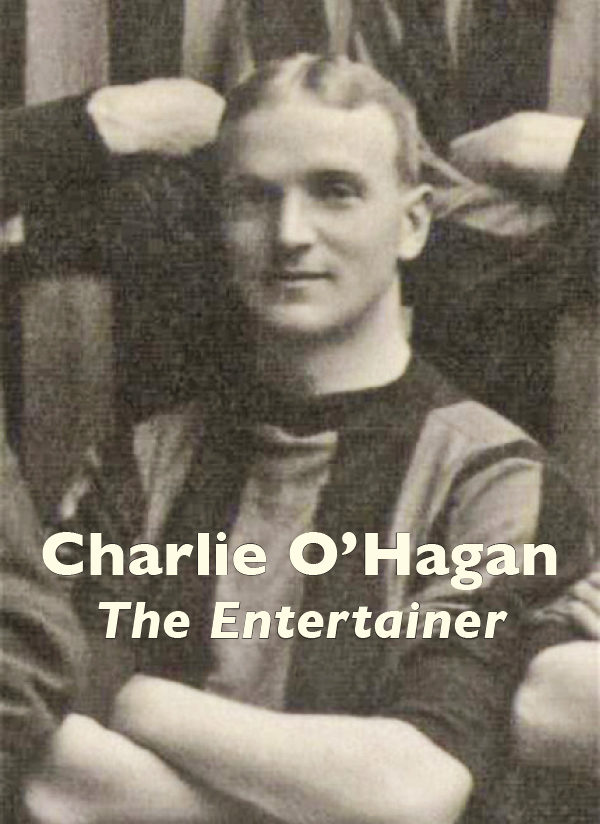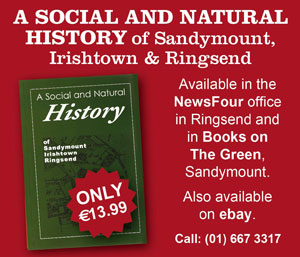
By Gavan Bergin
Charlie O’Hagan was born in Buncrana, County Donegal in July 1882. He was raised in the village of Linsfort, where his father ran the local shop.
As a boy, Charlie played football and by the time he was in secondary school he was a very promising player. Although he spent a lot of his time at football, he didn’t neglect his work at school and when he left at the age of sixteen, he moved to Derry to attend St Columb’s College.
When he got there, Charlie started playing for the college’s football club, St Columb’s Court. They were in the Ulster Junior League when Charlie arrived, but within a few years he had helped them to the top level of Irish football – the Irish League. This was an astonishing, almost unbelievable achievement for such team such as St Columb’s, but when the 1901/02 season kicked off, there they were, an Irish League team, standing as equals alongside the likes of Linfield and Cliftonville, the famous grand old clubs of Irish football.
Unfortunately for St Columb’s, once the season started everything went downhill. The team was utterly outclassed in the top flight and they failed to win a single match all year. They finished last and were relegated from the League at the end of the season.
St Columb’s Court went down, but Charlie didn’t go with them. He had played exceptionally well from the start, quickly proving that he was good enough for the top flight, and midway through the season he moved to the League’s other local cub, Derry Celtic.
By the end of that ‘01/’02 season, he had earned himself a reputation as one of Ireland’s best young players. At that stage, it was most likely that he would play at least one more season in the Irish League, before perhaps getting the opportunity of a move to an English club.
But Charlie did not do what was anticipated. The wandering spirit must have struck him hard in the summer of 1902, because he quit his college studies, left Derry Celtic and Irish football and emigrated to England.
He made his way to Liverpool, where he took a job in the office of a Spanish fruit merchant and kept his football skills sharp by playing for a club named Old Xavierians in the local amateur league. Charlie was bound to stand out and before long he was spotted by the local Division One team, Everton FC.
Charlie signed with Everton in March 1903, but never managed to break into their first team and he was transferred to Tottenham Hotspur in May 1904.
The move to Tottenham worked out brilliantly for Charlie. He went straight into the Tottenham side for the start of the ‘04/’05 season, performed splendidly and earned a place as the first choice inside-left for Spurs.
Back then, teams were set up in a 2-3-5 formation, with a five-man forward line consisting of one centre-forward, two wingers and two inside-forwards, known as the inside-left and the inside-right. They have no exact equivalent in modern football, but they were pivotal players at the time. Wikipedia describes their role as “running and making space in the opposition defence, supporting the centre-forward with passes”. More succinctly, in ‘The Ball is Round’, David Goldblatt calls the inside-forwards “the brains of the team’s attack”.
That was something Charlie was particularly well equipped for. He was quick and smart, he passed the ball well and scored his fair share of goals. As well as doing his job effectively, Charlie liked to show some style in his play when the chance arose. His ability to produce effective and attractive football throughout his career would earn him the nickname of ‘the born entertainer’. He spent two good years entertaining the Spurs supporters, and they were sorry to see him go when he signed for Middlesbrough after the ‘05/’06 season.
Charlie made his Division One debut for Middlesbrough, against Bury FC in September 1906,. He played well in that first match and did even better in his second game when he scored against Manchester City.
That was his first ever Football League goal, and at the time it must have looked like it would be the first of many in the top flight. But that fine start proved to be the high point of his time with Middlesbrough. Charlie lost his place in the side to the England international, Wilf Common, who was the most expensive player ever in the history of the Football League, and therefore bound to be Middlesbrough’s first choice inside-left.
So Charlie was dropped to the reserve team, but he was too good a player to be stuck there for too long. In December 1906, the Scottish Division One club, Aberdeen, paid the transfer fee of £175 to Middlesbrough for Charlie. He received a signing-on fee from Aberdeen of £10, which was a considerable sum at a time when football’s maximum wage rule meant that even the top players in England were on just £4 a week.
And Charlie paid Aberdeen back handsomely for their investment in him. Between 1906 and 1910, he produced some of the most impressive form of his entire career. In his second season in Scotland he helped Aberdeen get to the Scottish Cup semi-final for the first time ever. During his four seasons with them he scored 24 goals in 112 matches for Aberdeen, and they never lost a game that Charlie scored in.
In July 1910, Charlie moved to Morton FC, for whom he scored at an even more impressive rate than he had at Aberdeen. In less than two years at Morton, he scored 22 goals in 55 matches. He left Morton and joined Third Lanark, but played only a few games for them and retired from playing football in April 1912.
Charlie also played international football for Ireland. He made his debut against Scotland in Glasgow on March 3rd 1905, becoming the second Tottenham man ever to play for Ireland after Jack Kirwan the Wicklow born outside-left. Charlie and Jack played together for Tottenham and linked well for Ireland against a fine Scottish side.
Charlie’s performance in his first international match was impressive enough to earn him a starting place in Ireland’s next game, against Wales in Belfast on April 4th 1905.



